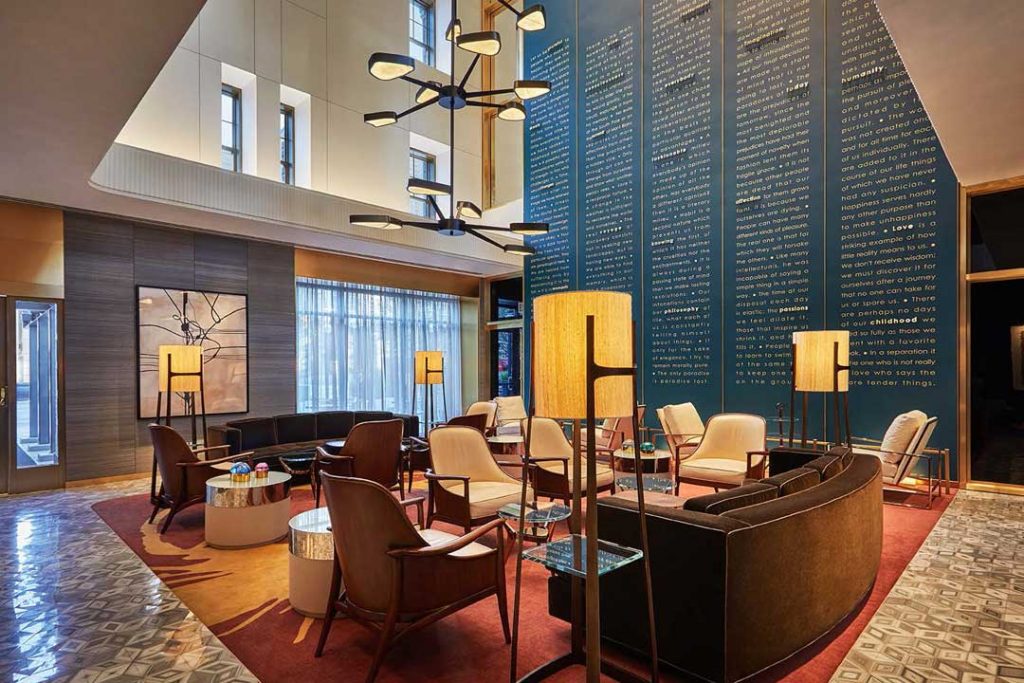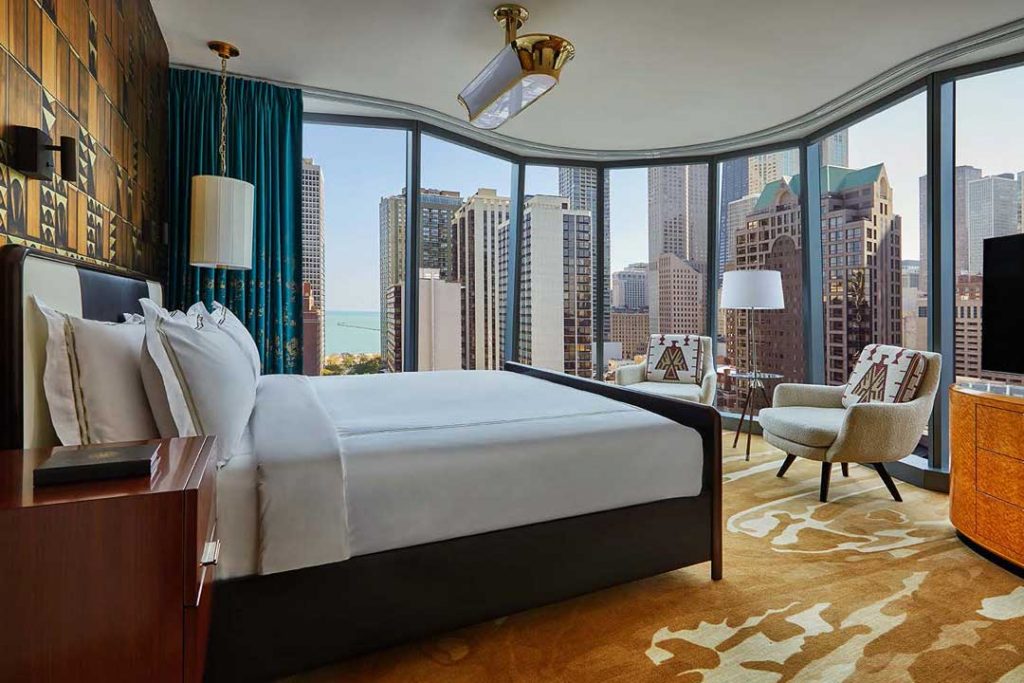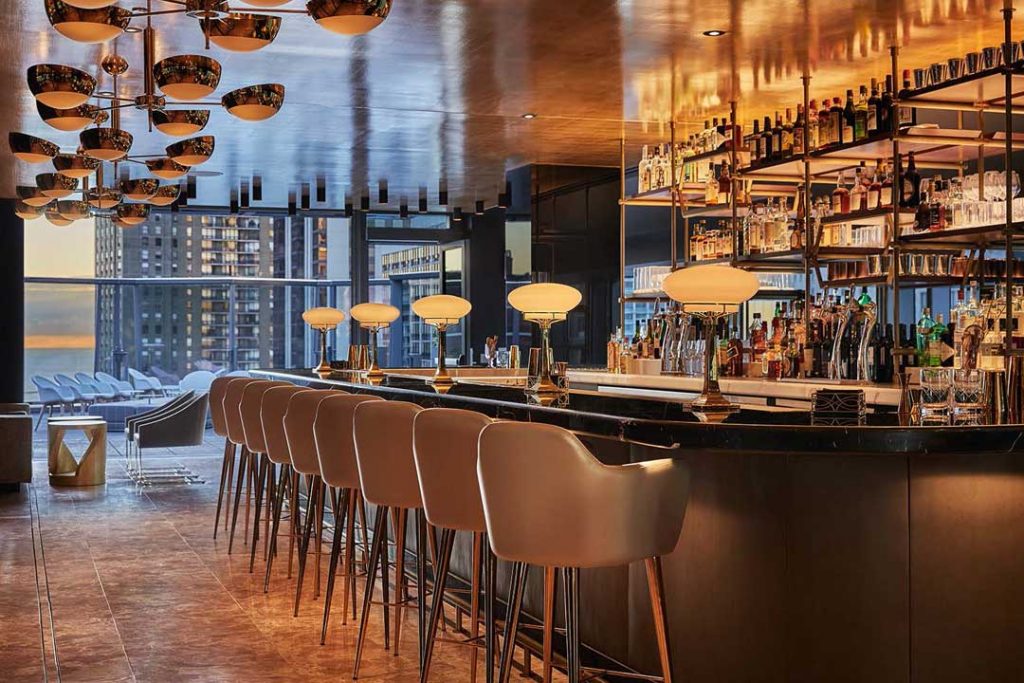Distinctive image inside and out for the old Cedar Hotel
Architect Goettsch Partners and hospitality design firm TAL Studio have worked together to deliver a distinctive image inside and out for Viceroy Hotel Group’s new Viceroy Chicago.
The development, managed by Chicago-based Convexity Properties, pays homage to the history of Chicago with curated architecture, design, art and style.
Historic Architecture
Located at the intersection of Cedar and State streets in Chicago’s Gold Coast neighborhood, the historic Cedar Hotel has taken on a new identity as the first Viceroy property in the Midwest.
The four-story brick-and-terracotta façade of the original Cedar Hotel has been preserved and given fresh life, fronting a striking new 18-story glass hotel tower.
Visitors enter an open, three-story lobby space with an adjacent restaurant, Somerset, from Chicago’s Boka Restaurant Group. Additional amenities include a ballroom and conference suite on level four, with access to a large outdoor terrace overlooking State Street.

The rooftop lounge, Devereaux, also helmed by Boka Restaurant Group, offers an outdoor pool and landscaped terrace, with stunning views of Lake Michigan and the Chicago skyline.
A unique image for the Viceroy emerges through the contrasting façades of the new tower and the historic building. The brick and terra cotta of the 1920s-era Cedar Hotel exemplifies the vintage character of a building façade as a two-dimensional arrangement of building elements and ornamentation.
By contrast, the glass curtain wall of the new hotel tower is a taut, three-dimensional envelope. The “folding” geometry is inspired by the argyle-like pattern found in the historic brick façade below. The design solution creates “harmony through contrast” in which both the old and new are rich examples of their specific eras.
Interior Design
Interior design comes from luxury design firm TAL Studio. The lobby space is adorned with white marble, brass light fixtures, and a one-of-a-kind 30-foot art wall tableau towering over the lobby living room with inscribed quotes from French poet Marcel Proust.
Inspired by the Flâneur, a French literary figure, principal designer Todd-Avery Lenahan, CEO and founder of TAL Studio, used the spirited character to create what are termed surprise-and-delight moments throughout the hotel. The tableau is dramatically lit each night, filled with the collection of Proust’s works.

“The overall interior design plans were one-of-a-kind, created with detail, precision and the highest quality, resulting in an authentic, inspired and dynamic experience for guests with many dimensions and nuances of design,” said Lenahan. “The objective was to create a dynamic connection between two potentially disparate archetypes. As a juxtaposition to the historic facade, the arrival library’s remaining three walls establish a hierarchy of monumental scale with the over 30-foot-tall Proust tableau towering over the library with colorful graphic bravado, while simultaneously being quietly elegant in its precise, shimmering presentation of thousands of meaningful words to be contemplated by each view on his or her own terms.”
Just beyond the library, large bronze reception desks welcome guests, positioned in front of a large painting depicting a Venetian carnival recital by South American Cubist artist Badi. The celebratory hues of this painting are seen throughout the hotel, appearing individually in the guestrooms and hallways to represent an artist’s palette before colors are incorporated into a larger painting.
Guestrooms host enlarged, luxurious bathrooms and closets, and a selection of suites offer expansive terraces with views of the cityscape and Lake Michigan. Cubist figural artwork in the guestrooms are reproductions of Cubist artist Miette Brave. A distinct headboard wall is a digital reproduction of an original work produced by London artist Tim Modus. The display is inspired by the architectural elements and sculptural forms of the midcentury and serve as a nod to Chicago’s storied architectural history.
Furnishings are mid-century inspired that recall the iconic, endearing and enduring period of Chicago’s architectural history.
Lenahan added: “When it comes to great design, it must exceed consumer expectations of what constitutes anticipatory and intuitive design, provoking positive emotional response, and is contextual and respectful of honoring the culture and location, while building loyalty with assurances of future patronage. As a designer, it’s essential to be a humble student of the cultural, social, geographic, economic, political and even spiritual history of a place to imbue the project with the sincerity and authenticity that create a true sense of place.”



